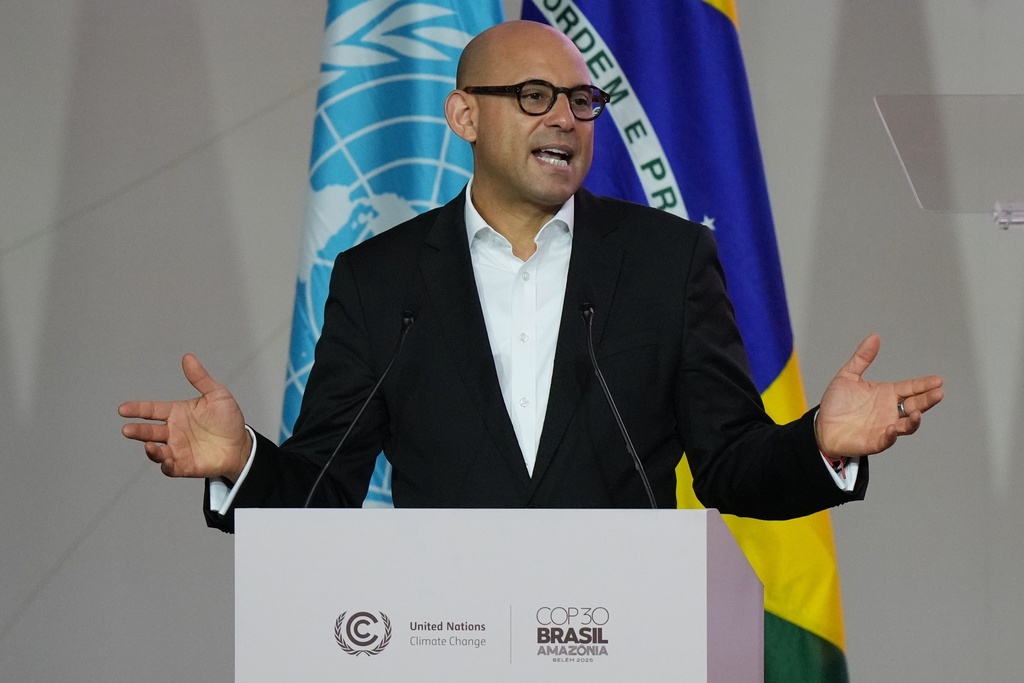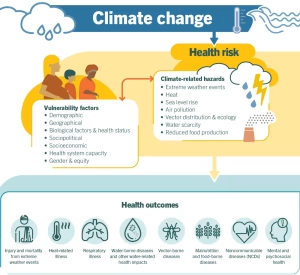UN climate chief highlights progress at COP30, urges intensified efforts – chinadailyasia.com

Report on the COP30 Action Agenda and its Alignment with Sustainable Development Goals
Executive Summary
At the 30th UN Climate Change Conference (COP30) in Belem, Brazil, UN Climate Change Executive Secretary Simon Stiell delivered a progress report on the COP30 Action Agenda. The report emphasizes the critical need to translate climate commitments into tangible actions that directly support the 2030 Agenda for Sustainable Development. The conference highlighted significant advancements in global climate cooperation, framing them as essential drivers for achieving multiple Sustainable Development Goals (SDGs), with a primary focus on SDG 13 (Climate Action).
Key Achievements in Advancing the SDGs
Mr. Stiell outlined a series of achievements at COP30, which represent concrete progress toward an integrated climate and development agenda. These actions are designed to foster stronger economies, create employment opportunities, and improve quality of life, aligning with several SDGs.
- Energy and Infrastructure Development:
- Major investments in clean energy and grid modernization directly support SDG 7 (Affordable and Clean Energy).
- A global plan to quadruple the use of sustainable fuels contributes to SDG 9 (Industry, Innovation and Infrastructure) and SDG 12 (Responsible Consumption and Production).
- Economic and Social Advancement:
- Efforts to unlock new green industries are projected to stimulate economic growth and create employment, advancing SDG 8 (Decent Work and Economic Growth).
- An expanding pipeline of climate-adaptation funding aims to build resilience and protect vulnerable communities, contributing to SDG 1 (No Poverty) and SDG 11 (Sustainable Cities and Communities).
- Comprehensive National Planning:
- The adoption of whole-of-economy and whole-of-society approaches in national climate plans demonstrates a systemic shift, reflecting the interconnected nature of the SDGs and fostering SDG 17 (Partnerships for the Goals).
The COP30 Action Agenda: A Framework for SDG Implementation
The report stressed the urgency of accelerating implementation to achieve measurable results. The COP30 Action Agenda has been strategically aligned with negotiation processes to ensure that commitments are rooted in practical solutions. The agenda prioritizes 30 objectives that serve as a roadmap for integrated action on climate and sustainable development.
Priority Areas for Mitigation, Adaptation, and Implementation:
- Systems Transformation:
- Transitioning energy, industry, and transport systems to sustainable models, directly targeting SDG 7, SDG 9, and SDG 11.
- Ecosystem Stewardship:
- Stewarding forests, oceans, and biodiversity to protect natural habitats, crucial for achieving SDG 14 (Life Below Water) and SDG 15 (Life on Land).
- Food and Agriculture:
- Transforming agriculture and food systems to ensure food security and sustainable practices, in line with SDG 2 (Zero Hunger).
Mr. Stiell concluded by urging all stakeholders to intensify efforts to deliver results “fast, fairly, and at scale,” reinforcing that effective climate action is inseparable from the broader mission of achieving the Sustainable Development Goals.
Analysis of SDGs in the COP30 Article
1. Which SDGs are addressed or connected to the issues highlighted in the article?
-
SDG 7: Affordable and Clean Energy
The article directly mentions “major clean-energy and grid investments” and a “global plan to quadruple sustainable fuels,” which are central to ensuring access to affordable, reliable, sustainable, and modern energy for all.
-
SDG 8: Decent Work and Economic Growth
The text states that climate actions will lead to “stronger economies, more jobs and better lives for many millions” and efforts to “unlock new green industries.” This connects climate action with the promotion of sustained, inclusive, and sustainable economic growth and productive employment.
-
SDG 9: Industry, Innovation, and Infrastructure
The focus on “transitioning energy, industry and transport” and unlocking “new green industries” aligns with building resilient infrastructure, promoting inclusive and sustainable industrialization, and fostering innovation.
-
SDG 11: Sustainable Cities and Communities
The goal of “transitioning… transport” is a key component of making cities and human settlements inclusive, safe, resilient, and sustainable.
-
SDG 13: Climate Action
This is the central theme of the article. The entire text discusses the COP30 Action Agenda, which focuses on “climate mitigation, adaptation,” efforts to “cut emissions and strengthen resilience,” and the creation of “national climate plans.”
-
SDG 14: Life Below Water
The article explicitly mentions “stewarding… oceans” as a major area for climate action, directly linking to the conservation and sustainable use of oceans, seas, and marine resources.
-
SDG 15: Life on Land
The commitment to “stewarding forests… and biodiversity” is a direct reference to protecting, restoring, and promoting the sustainable use of terrestrial ecosystems and halting biodiversity loss.
-
SDG 17: Partnerships for the Goals
The article emphasizes “climate cooperation” and the role of the UN Climate Change Conference (COP30) as a global platform for collaboration. This reflects the need to strengthen the means of implementation and revitalize the global partnership for sustainable development.
2. What specific targets under those SDGs can be identified based on the article’s content?
-
SDG 7: Affordable and Clean Energy
- Target 7.2: By 2030, increase substantially the share of renewable energy in the global energy mix. This is directly supported by the article’s mention of “major clean-energy and grid investments.”
-
SDG 9: Industry, Innovation, and Infrastructure
- Target 9.4: By 2030, upgrade infrastructure and retrofit industries to make them sustainable. This is reflected in the article’s reference to “transitioning energy, industry and transport” and efforts to “unlock new green industries.”
-
SDG 13: Climate Action
- Target 13.1: Strengthen resilience and adaptive capacity to climate-related hazards and natural disasters in all countries. The article highlights this through its focus on “climate-adaptation funding” and the goal to “strengthen resilience.”
- Target 13.2: Integrate climate change measures into national policies, strategies and planning. This is explicitly mentioned as the development of “national climate plans” where “whole-of-economy and whole-of-society approaches are taking shape.”
-
SDG 14: Life Below Water
- Target 14.2: By 2020, sustainably manage and protect marine and coastal ecosystems. The commitment to “stewarding… oceans” directly relates to this target.
-
SDG 15: Life on Land
- Target 15.2: By 2020, promote the implementation of sustainable management of all types of forests. This is addressed by the objective of “stewarding forests… and biodiversity.”
3. Are there any indicators mentioned or implied in the article that can be used to measure progress towards the identified targets?
The article does not mention specific, official SDG indicators, but it implies several metrics that can be used to measure progress. It calls for “measurable, real-world results” and refers to an “impressive scorecard of real-world climate actions.”
- Financial Investment: The mention of “major clean-energy and grid investments” and an “expanding pipeline of climate-adaptation funding” implies that the amount of capital mobilized for these purposes is a key indicator of progress.
- Growth of Green Industries: The goal to “unlock new green industries” suggests that the number of new green businesses, the jobs created in these sectors, and their contribution to GDP could be used as indicators.
- Policy Implementation: The reference to “national climate plans” implies that an indicator would be the number of countries that have developed and are implementing comprehensive climate strategies.
- Emission Reductions: The objective to “cut emissions” directly points to the use of greenhouse gas emission levels (e.g., tonnes of CO2 equivalent) as a primary indicator of success in climate mitigation.
- Sustainable Fuel Production: The “global plan to quadruple sustainable fuels” provides a clear, quantifiable target. An indicator would be the volume or percentage increase in the production and use of these fuels.
4. Summary Table of SDGs, Targets, and Indicators
| SDGs | Targets | Indicators (Implied from the Article) |
|---|---|---|
| SDG 7: Affordable and Clean Energy | 7.2: Increase the share of renewable energy. | – Amount of “clean-energy and grid investments.” – Volume of production of “sustainable fuels.” |
| SDG 8: Decent Work and Economic Growth | Promote sustainable economic growth and green jobs. | – Number of “jobs” created through climate actions. – Growth of “stronger economies” linked to green transitions. |
| SDG 9: Industry, Innovation, and Infrastructure | 9.4: Upgrade infrastructure and retrofit industries to make them sustainable. | – Number of “new green industries” unlocked. – Progress in “transitioning energy, industry and transport.” |
| SDG 13: Climate Action | 13.1: Strengthen resilience and adaptive capacity. 13.2: Integrate climate change measures into national policies. |
– Amount of “climate-adaptation funding” mobilized. – Reduction in greenhouse gas emissions (“cut emissions”). – Number of countries with “national climate plans.” |
| SDG 14: Life Below Water | 14.2: Sustainably manage and protect marine ecosystems. | – Implementation of programs for “stewarding… oceans.” |
| SDG 15: Life on Land | Promote sustainable management of forests. | – Implementation of programs for “stewarding forests… and biodiversity.” |
| SDG 17: Partnerships for the Goals | Enhance global partnerships for sustainable development. | – Level of “climate cooperation” among nations. |
Source: chinadailyasia.com
What is Your Reaction?
 Like
0
Like
0
 Dislike
0
Dislike
0
 Love
0
Love
0
 Funny
0
Funny
0
 Angry
0
Angry
0
 Sad
0
Sad
0
 Wow
0
Wow
0

















































.jpg.webp?itok=0ZsAnae9#)





:focal(1500,1000)/https://media.globalcitizen.org/a6/9a/a69a4720-d8a1-4715-b596-18738d03c05c/rotary_polio_hero_image.jpg?#)



















